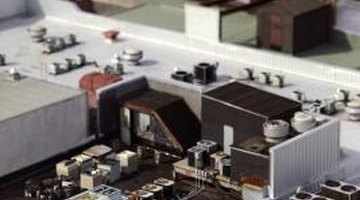Building an AC Stand on the Roof
Because of the copper in their evaporators and condensers, along with the cast iron typically used to make motors and compressors, air conditioning units are extremely heavy for their size. Their weight creates a risk of catastrophic damage, and a potential for injury to occupants, should a roof-mounted unit come free of its stand and plummet into the building below. Building a roof-top air conditioner stand from scratch is therefore not recommended. However, numerous licensed companies manufacture dedicated equipment specifically for mounting air conditioners on roofs; installation practices for these stands have many common factors.

Step 1
Consult with the code enforcement office in the municipality where the installation is to take place. Ensure that the stand will be of sufficient strength to withstand the worst conditions that can be expected in your region. Those that exceed the building codes in Dade, Broward and Palm Beach counties in Florida, for instance, are required to be engineered to survive extreme hurricane force conditions.
Step 2
Confirm that the stand you are considering supports the configuration of the air conditioner unit to be installed. Different air conditioner manufacturers build differently shaped machines; some are wide, rectangular and low, while others are taller with a smaller, square “footprint.”
Step 3
Locate the stand so that it is supported by under-roof reinforcements adequate to the total weight loading. The flat roofs of commercial and industrial buildings are often made from beams of precast concrete, designed to accept the considerable loading of multiple air conditioner units. The peaked-and-eaved roofs of most homes are not, and considerable reinforcement may be required.
Step 4
Install the stand adhering to all instructions and advisements supplied by the manufacturer. Extend the legs of the stand so that the minimum clearances mandated by the instructions are met; local code often designates a minimum clearance beneath the stand, which also mandates leg height. Typically, the larger the air conditioner unit, the greater the minimum clearance. These clearances are determined by calculations that factor in air movement, heat dispersion and torsional weight loading. Allow sufficient space below the stand so that any reroofing that may eventually be needed can take place without necessitating the removal of the air conditioner unit and the stand.
Step 5
Create conduits for the pipes, cables and ducts integral to the air conditioner system. Route all electrical wiring through a watertight conduit, and include a fusible disconnection device.
Step 6
Install all securing devices as recommended by the manufacturer to ensure that the stand is capable of withstanding the most extreme weather conditions likely to be encountered. Failure of any rooftop component can result in water entering the building, even if the air conditioner unit and stand remain in place. Wind-borne debris can damage other building components. Secure the stand using straps attached directly to a sufficiently sturdy part of the roof deck. Ducts, pipework and conduits must all be properly protected from undesired movement; ductwork that cannot be located inside the building should be encased in reinforced concrete masonry units, or “CMUs” in industry-speak.
Step 7
Fit a vibration reduction device if necessary. Rubber mounting pads installed between the stand and the air conditioning unit are often successful at insulating the structure of the building supporting the stand from the vibrations inherent in the operation of an air conditioner compressor.
References
Tips
- Choose the right air conditioner system for your needs. While most domestic installations use a single unit that comprises all the components making up the system, larger commercial and industrial installations typically locate only the condenser on the roof while housing air handlers and control systems inside the building.
- Prefabricated stands are manufactured in a number of configurations designed to support as many as six units and up to 100 tons of weight; larger stands typically have to be special-ordered. For the latter, the engineers will require notification of the height, length, width and weight of your AC units, the building height and the type of roof, be it concrete, steel or wood.
Warnings
- The roof-mounted cooling units commonly seen on homes in the southwest of the country are not typically air conditions; rather, they are evaporative -- commonly called “swamp” -- coolers. These machines do not have compressors, copper pipe or motors, and therefore weigh much less than air conditioners. It is vital to ensure that a roof is strong enough to support an air conditioner before a roof-top stand system is considered.
- Observe all best safety practices when working on roofs. Ladders and scaffolding structures have procedural instructions that you must follow. Equipment rented from specialty companies and home improvement warehouses should come with comprehensive safe working instructions; most companies mandate that their staff give a short instructional presentation when transferring equipment to a renter. Use the equipment in strict accordance with these advisements.
Writer Bio
John Cagney Nash began composing press releases and event reviews for British nightclubs in 1982. His material was first published in the "Eastern Daily Press." Nash's work focuses on American life, travel and the music industry. In 1998 he earned an OxBridge doctorate in philosophy and immediately emigrated to America.
Photo Credits
- Thinkstock/Comstock/Getty Images
More Articles



